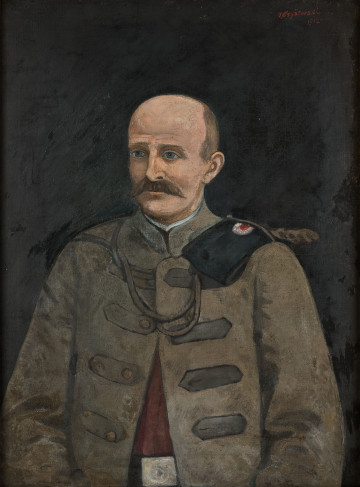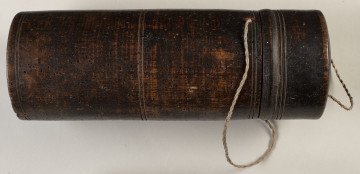
Two-door cabinet
18th-19th century
Castle Museum in Łańcut
Part of the collection: Historia miasta i regionu
A rosolio bottle with the Pilawa coat of arms and the monogram of Count Alfred Potocki and the name of the city, as well as a colourful label with the inscription „Uprzywilejowana Krajowa Fabryka Likierów hrabiego Potockiego w Łańcucie, Rosolis, Złotopłyn.” (Privileged National Liquor Factory of Count Potocki in Łańcut, Rosolio, Złotopłyn.) The bottle dates back to the final period of the factory’s operation, which was launched in the 18th century. Before it began to produce rosolio and other high quality liquors, the plant was a simple distillery, producing aqua vitae. After the estate has been taken over by the First Ordinate, Count Alfred Potocki, it changed its profile. In 1838, the distillery was transformed into a modern factory, supplying the market with the best kinds of vodkas at that time. In addition to liqueurs and rosolio, the plant made rum and even cologne, and badly fermented alcohols were turned into vinegar. In 1857 the plant was registered at the Chamber of Commerce in Krakow under the name „c.k. uprzywilejowana Fabryka krajowa Hr. Potockiego wyrobu rosolisów, likierów, rumu, octu i wody kolońskiej”. 1889 saw a change in the production – the plant focused on refining, and in 1893 it was renamed to “Rafineria spirytusu ces. król. uprzyw. fabryka krajowa rosolisów, likierów i rumu Romana hr. Potockiego w Łańcucie”. A decision was also made to expand the plant, moving it to new buildings in 1911, which made it possible to use new equipment. During World War I, the company was split into two separate entities, namely “Ces. Król. Uprzywil. Krajowa fabryka likierów rosolisów i rumu hrabiego Alfreda Potockiego. Podzwierzyniec-Łańcut” and “Rafineria spirytusu uznana za wolny skład hrabiego Alfreda Potockiego. Podzwierzyniec-Łańcut”. The former remained a private property of the Fourth Ordinate, Count Alfred Potocki, while the latter was transformed into a company named “Towarzystwo dla przemysłu spirytusowego i chemicznego. Spółka akcyjna w Łańcucie”. At the same time, the construction of a new bottling plant for quality vodkas started and was successfully completed in 1922. The production was based on spirit from the local refinery, as well as liqueur essences supplied by the local Wilford LTD plant. Joanna Kluz
Dimensions
height: 23.3 cm, width: 9 cm
Object type
History of the city and the region
Technique
cast
Material
paper, glass
Creation time / dating
Creation / finding place
Owner
Castle Museum in Łańcut
Identification number
Location / status

18th-19th century
Castle Museum in Łańcut

20th century
Castle Museum in Łańcut

19th / 20th century
Castle Museum in Łańcut
DISCOVER this TOPIC
National Museum in Lublin
DISCOVER this PATH
Educational path